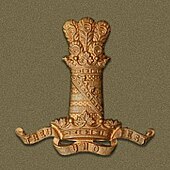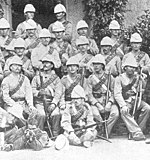
The Royal Armoured Corps is the armoured arm of the British Army, that together with the Household Cavalry provides its armour capability, with vehicles such as the Challenger 2 and the Warrior tracked armoured vehicle. It includes most of the Army's armoured regiments, both the Royal Tank Regiment and those converted from old horse cavalry regiments. In September 2024, it comprised fourteen regiments: ten Regular Regiments; four Army Reserve. Although the Household Cavalry Regiment provide an armoured regiment, they are not part of the RAC.

The Light Dragoons (LD) is a cavalry regiment in the British Army. The regiment has a light cavalry role and specialises in mounted and dismounted reconnaissance. The Light Dragoons recruit mainly in Northern England, from County Durham, Northumberland, Tyne and Wear, South Yorkshire and the East Riding of Yorkshire. For this reason, the regiment is known as "England's Northern Cavalry". It is currently based in Catterick Garrison, North Yorkshire.

The Buffs (Royal East Kent Regiment), formerly the 3rd Regiment of Foot, was a line infantry regiment of the British Army traditionally raised in the English county of Kent and garrisoned at Canterbury. It had a history dating back to 1572 and was one of the oldest regiments in the British Army, being third in order of precedence (ranked as the 3rd Regiment of the line). The regiment provided distinguished service over a period of almost four hundred years accumulating one hundred and sixteen battle honours. In 1881, under the Childers Reforms, it was known as the Buffs (East Kent Regiment) and later, on 3 June 1935, was renamed the Buffs (Royal East Kent Regiment).

The 5th Royal Inniskilling Dragoon Guards was a cavalry regiment of the British Army formed in 1922 by the amalgamation of the 5th Dragoon Guards and the 6th (Inniskilling) Dragoons. It served in the Second World War and the Korean War. In August 1992, as a consequence of the Options for Change defence cuts, the regiment was amalgamated with the 4th/7th Royal Dragoon Guards to form the Royal Dragoon Guards.

The 15th/19th The King's Royal Hussars was a cavalry regiment of the British Army. The regiment was formed by the amalgamation of the 15th The King's Hussars and the 19th Royal Hussars in 1922 and, after service in the Second World War, it was amalgamated with the 13th/18th Royal Hussars to form the Light Dragoons in 1992.

The 13th/18th Royal Hussars was a cavalry regiment of the British Army. It was formed by the amalgamation of the 13th Hussars and the 18th Royal Hussars in 1922 and, after service in the Second World War, it amalgamated with the 15th/19th The King's Royal Hussars to form the Light Dragoons in 1992.

The Royal Hussars (Prince of Wales's Own) was a cavalry regiment of the British Army. It was formed by the amalgamation of the 10th Royal Hussars and the 11th Hussars in 1969 and it amalgamated with the 14th/20th King's Hussars to form the King's Royal Hussars in 1992.

The 10th Royal Hussars (Prince of Wales's Own) was a cavalry regiment of the British Army raised in 1715. It saw service for three centuries including the First World War and Second World War but then amalgamated with the 11th Hussars (Prince Albert's Own) to form the Royal Hussars (Prince of Wales's Own) in October 1969.

The 13th Hussars was a cavalry regiment of the British Army established in 1715. It saw service for three centuries including the Napoleonic Wars, the Crimean War and the First World War but then amalgamated with the 18th Royal Hussars, to form the 13th/18th Royal Hussars in 1922.

The 20th Hussars was a cavalry regiment of the British Army. After service in the First World War it was amalgamated with the 14th King's Hussars to form the 14th/20th King's Hussars in 1922.

The 14th King's Hussars was a cavalry regiment in the British Army, first raised in 1715. It saw service for two centuries, including the First World War, before being amalgamated with the 20th Hussars to form the 14th/20th King's Hussars in 1922.

The 19th Royal Hussars (Queen Alexandra's Own) was a cavalry regiment of the British Army, created in 1858. After serving in the First World War, it was amalgamated with the 15th The King's Hussars to form the 15th/19th The King's Royal Hussars in 1922.

The 12th Royal Lancers was a cavalry regiment of the British Army first formed in 1715. It saw service for three centuries, including the First World War and the Second World War. The regiment survived the immediate post-war reduction in forces, but was slated for reduction in the 1957 Defence White Paper, and was amalgamated with the 9th Queen's Royal Lancers to form the 9th/12th Royal Lancers in 1960.

The 2nd Dragoon Guards (Queen's Bays) was a cavalry regiment of the British Army. It was first raised in 1685 by the Earl of Peterborough as the Earl of Peterborough's Regiment of Horse by merging four existing troops of horse.

The 6th (Inniskilling) Dragoons was a cavalry regiment in the British Army, first raised in 1689 as Sir Albert Cunningham's Regiment of Dragoons. One of the regiment's most notable battles was the Battle of the Boyne in July 1690. It became the 6th (Inniskilling) Regiment of Dragoons in 1751. The regiment also fought with distinction in the Charge of the Union Brigade at the Battle of Waterloo and again as part of the successful Charge of the Heavy Brigade against superior numbers at the Battle of Balaclava during the Crimean War.

The 3rd Hussars was a cavalry regiment of the British Army, first raised in 1685. It saw service for three centuries, including the First and the Second World Wars, before being amalgamated with the 7th Queen's Own Hussars, to form the Queen's Own Hussars in November 1958.

The 4th Queen's Own Hussars was a cavalry regiment in the British Army, first raised in 1685. It saw service for three centuries, including the First World War and the Second World War. It amalgamated with the 8th King's Royal Irish Hussars, to form the Queen's Royal Irish Hussars in 1958.

The 8th King's Royal Irish Hussars was a cavalry regiment in the British Army, first raised in 1693. It saw service for three centuries including the First and Second World Wars. The regiment survived the immediate post-war reduction in forces, and went on to distinguish itself in the battles of the Korean War, but was recommended for amalgamation in the 1957 Defence White Paper prepared by Duncan Sandys. The regiment was amalgamated with the 4th Queen's Own Hussars, to form the Queen's Royal Irish Hussars in 1958.

The 15th The King's Hussars was a cavalry regiment in the British Army. First raised in 1759, it saw service over two centuries, including the First World War, before being amalgamated with the 19th Royal Hussars into the 15th/19th The King's Royal Hussars in 1922.

The 7th Queen's Own Hussars was a cavalry regiment in the British Army, first formed in 1689. It saw service for three centuries, including the First World War and the Second World War. The regiment survived the immediate post-war reduction in forces, but following the 1957 Defence White Paper, it was amalgamated with the 3rd The King's Own Hussars, forming the Queen's Own Hussars in 1958.



























